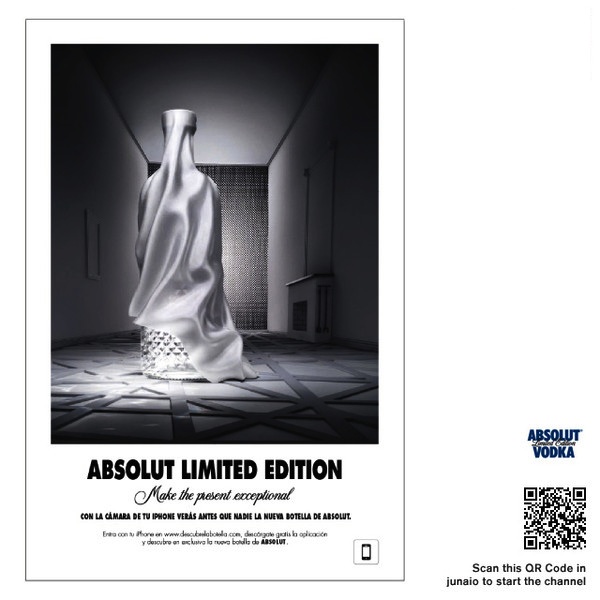Augmented reality is one of those technologies that are attractive, fun, but that has everybody wondering why is it useful. The truth is that the possibility of adding virtual information to the real world can be useful in many sectors such as advertising, communication, retail, real estate sales, gaming, tourism, education, automotive… In fact, any sector trying to capture the attention of its customers through mobile devices should use augmented reality as a promotional tool.
No company in the world can have today a business strategy ignoring mobile devices: more and more people consume information online and buy products through their smartphones. Gartner published a report estimating that the number of mobile devices sold in 2014 will reach 1,9 billion (3% more than in 2013), and that 66% of those units would be smartphones (88% by 2018). There is no doubt that we have more technology and better connected users. Hence, the possibilities for companies are endless.
“Augmented” advertising
Many brands are using augmented reality to advertise their products, find potential clients and even obtain data on their profiles as buyers. And all this thanks to applications that must be installed on phones to access the opportunities offered by this technology. Companies like Ikea, Cadillac or Mercedes-Benz have had positive experiences with augmented reality.
We guess the Swedish furniture giant asked the same question that many buyers aks themselves (“How is this sofa going to look in my living room?”) when it decided to invest in this technology. It’s not the same to see a sofa in one of the large halls of the store than having the opportunity to place it in your own house, and to even sit on it. This video is spectacular:
Two major automotive companies like Cadillac and Mercedes have also experimented with augmented reality to bring their cars to the customers without having to go to a dealer… just with the use of a mobile phone or a tablet. These two videos are a perfect example of the possibilities of this technology:
A potential market for Spanish tourism
Tourists from around the world seek different experiences when traveling. Guidebooks are very useful if you want to locate monuments and restaurants in a big city, but augmented reality can offer that and also provide added value that can hardly be included in a sheet of paper: interactivity.
Nadia Cervera, an art historian, and Luis López, an economist, started a project in 2011 that has culminated with the launch of Guideo, an application of augmented reality and geolocation that allows tourists to enjoy interactive tours in Cadiz, Malaga and Seville and experience firsthand the cultural and historical aspects of a city. For example, they can listen to a typical “saeta” in front of the door of an historical monument.
A virtual tour to the apartment of your dreams
Augmented reality can be a fun and effective way to seduce clients interested in real estate developments. This technology has reached very precise levels, being capable to recreate buildings with 30 floors and even place mobile users in a specific floor. Real estate investing based only on paper architectural plans is history; now you can explore a building using a mobile device, just as if you were inside, with an incredible level of realism. Watch this video:
Learn in a fun way
One of the applications of augmented reality is e-learning. LearnAR is a tool that allows to learn practical subjects and to interact with the teacher in a very helpful way. Here you can see how it works:
Other interesting educational applications are interactive books. Can you imagine studying medicine with books that have 3D images? AR-Books is precisely dedicated to do that, designing books that can facilitate the learning of disciplines as diverse as medicine, makeup or technical drawing.
How to stimulate the illusion of customers
Companies such as Lego have been experimenting for some time with augmented reality to capture the attention of children. The toy company uses this technology to show customers the models they are about to buy: a simple way to help them choose their favorite product.
Hugo Boss, for example, uses augmented reality to get potential customers into its shop, have fun with interactive games and participate in contests to win a gift card.
Meanwhile, in the same retail sector, IBM launched a mobile application that allows customers to check the nutritional information of the food in supermarkets.
Augmented reality video games
The video games industry always drives innovation, which often is used by other sectors. It could not be otherwise: there are video games based on augmented reality.
The American company Technical Illusion is one of the references in the industry related to augmented reality applied to video games. They have designed glasses for augmented reality that allow a new 3D gaming experience. They are called CastAR and you can play alone or with more people. A similar device is Epson Moverio BT-200, augmented reality glasses with applications in different sectors (games, drones…) and with an intense development plan open to developers.
There are also much simpler and perhaps more addictive games. AR Soccer is a game that places a virtual ball at the feet of the user so he can kick it. Android video games to kill the typical cartoon characters or spacecraft are also a trend: Droid Shooting and ARDefender are two good examples. Sometimes the simplest thing becomes the most addictive.











